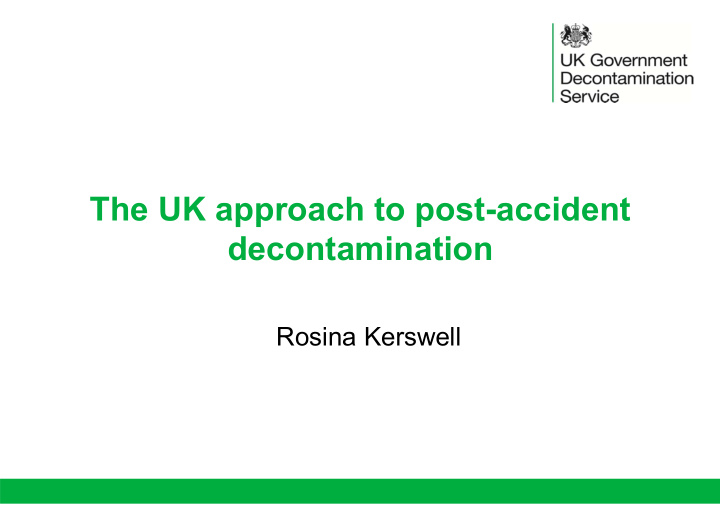



The UK approach to post-accident decontamination Rosina Kerswell
Contents • UK recovery response • Utilisation of private sector capabilities • Development of capabilities • Considerations
UK Recovery Response National National control coordinated Multi agency mechanism operational response response Private sector
Multi Agency Response • Private sector • Government implements private sector capability to support multi agency response in decontamination • This is managed by the UK Government Decontamination Service (GDS) • Part of Defra floods, water and CBRN Emergencies
GDS Remit Provide advice, guidance and support to those responsible for dealing with the consequences of an accidental or deliberate release of CBRN and hazardous materials; Enable quick access to a Framework of specialist suppliers able to offer expert decontamination and related services in response to a CBRN or major HazMat incident; Advise the Government on the national capability for the decontamination of buildings, infrastructure, transport assets and the open environment.
Default SAGE, STAC interaction model https://www.gov.uk/government/uploads/system/uploads/attachment_dat a/file/80087/sage-guidance.pdf
Who Can Use The Service? Government House of Crown House of Lords Ministers Departments Commons NI, Welsh and Any NHS UK overseas Any Local Scottish Healthcare territories Authority (LA) Assemblies trust Govt or LA National Parks Any UK Fire All UK Police joint ventures, & Broads Authority PFIs, etc Authority And others via respective Local Authorities
GDS Primary Functions Advice, guidance and support Operational Capability Framework
Advice • Broad capability to provide advice on issues outside the normal capabilities at a local level • Advice to local government on how to implement PHE guidance in handbook to be operationally deployable • Highlight gaps in capability and raising within central government
Private Industry Operational Capability Normal Counter Terrorism Environment Environment Nuclear power station Radiological Dispersal Devices maintenance, decommissioning (RDD) and Improvised Nuclear and legacy remediation Devices (IND) Anthrax remediation (dispersion Clinical sterilisation of Bacillus anthracis ) Industrial chemical spills and Deliberate releases of chemical asbestos removal warfare agents
GDS Framework 2016-2020 Radiological Chemical Biological Sampling, Sampling, Sampling, Monitoring and Monitoring and Monitoring and Analysis Analysis Analysis Decontamination Waste Management and Disposal Decontamination Decontamination National Arrangements for Waste Management Waste Management Incidents Involving and Disposal and Disposal Radioactivity (NAIR)
GDS Supplier Roles Sampling, monitoring & analysis to determine the extent of the contamination Prioritising the appropriate resources and equipment for decontamination Decontamination of the built and open environment, transport assets and other items Sampling and monitoring to assess the effectiveness of decontamination for reoccupation or reuse Managing contaminated waste (throughout)
Framework Costs No retainers are paid for resources or resourcing ££££
Assurance Supply chain Deployment resilience Exercise Building capability Research and Event development Deployment
Assurance Process Level 1 procurement process Level 2 paper-based assessment using based on previous industrial experience Level 3 paper-based assessments and workshops using CBRN planning scenarios Level 4 practical exercises using simulants in enclosed environments (offices etc) Level 5 practical exercises using real agents in realistic settings
Deployment Exercises • Assessment • Test lessons identified Challenging environment • Identify capability gaps • External independent assessors Temporary waste storage
Event Deployment • Relative of deceased contacted Public Health England • Local Authority requested help from GDS • Back garden radiochemistry laboratory
Research and Development • National and international collaboration • Information sharing • Technology Reference Levels • Academia • Working groups • Industry • National Decommissioning Authority • Sellafield
Supply Chain Resilience • Radiation monitoring instrumentation • Laboratory capability • Personal Protective Equipment • Logistical support • Waste packaging • Heavy machinery • Power supplies
Considerations • Procurement of additional resource and recourses • Supply chain • Release from day jobs • Training of additional staff to work in the radiation contaminated environment • Maintaining skills • Recovery teams working together • Radiation protection • Harmonised results • Scaling up of technologies for wide areas / large volumes • Difficult environment / terrain • Prioritisation of decontamination areas • Waste storage, agreement before operations begin
Considerations • Logistics • Utilities • Accommodation • Operation control • Housing for operational resourcing • Security, maintaining secure environment for public and workers during decontamination operations • Payment for decontamination operations • Value for money • Working with international partners
Summary • Example of how the UK uses private sector capability for multi agency response to decontamination • Developing decontamination capability through training, assessment and knowledge sharing • Considerations for decontamination operations
UK Government Decontamination Service www.gov.uk/government/groups/government-decontamination-service General Enquiries number: 0300 1000 315 gds@gds.gsi.gov.uk Building 14 MOD Stafford Beaconside Stafford ST18 0AQ UK Rosina.kerswell@defra.gsi.gov.uk
Recommend
More recommend